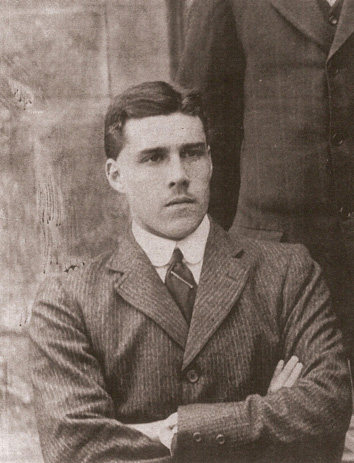Richard Poingdestre Wood was born on 9th November 1889 in Hampstead, London. He was educated at Cheltenham College between 1903 and 1908, after which he joined the Royal Military College at Sandhurst to train as an Officer. On passing out from college in 1912, Richard joined the York and Lancaster Regiment as a Lieutenant. He was seconded to the West Africa Regiment in May 1913 and rejoined the York and Lancaster Regiment on 6th August 1914, two days after war had been declared.
Just over a month later, on 9th September 1914, Richard and the 2nd Battalion, York and Lancaster Regiment were sent to France as part of the 18th Brigade, 6th Division. Ten days after landing at St Nazaire, Richard’s battalion was in reserve for the Battle of the Aisne and in October, the Battle of Armentieres.
The 2nd Battalion spent most of early 1915 based in a relatively quiet sector of the front, in Belgium. As a result, they saw little action. On 16th June, the battalion war diary reported that Richard had been promoted to Temporary Captain and put in command of “D” Company while based on the banks of the Yser Canal, near Ypres.
On 19th July 1915, a mine was detonated under a German stronghold near Hooge, creating a crater thirty-seven metres across and six metres deep. The crater was taken and held by the British until 30th July, when the German army counter-attacked using flamethrowers for the first time in the war. Richard’s battalion received orders on 31st July sending them to Hooge to relieve the 14th Division and to prepare for a counter attack to retake the crater. In a coordinated assault at 03.15 on 9th August 1915, the 6th Division launched an attack along a one-thousand-yard front with Richard’s “D” Company in the centre of his battalion’s formation. The action was entirely successful with all objectives recaptured.
On 9th September 1915, the first anniversary of the battalion arriving in France, their war diary recorded the number of men still serving with the battalion two hundred and forty-one from the original one thousand. It was also reported that Richard had been wounded between 7th and 18th September and was being treated in hospital. He wasn’t to return to the battalion until April the following year.
Between the 19th and 24th April 1916, the battalion was involved in an assault on the Morteldje Estaminet near Boesinghe in Belgium. In his report to the Divisional Commander, Brigadier General C L Nicholson of the 16th Brigade wrote:
“The work of the 2nd Bn. York and Lancaster Regt since they were sent up in support of the 8th Bedfordshire Regt on the night of 19/20th has been admirable. The only successful attack on the night of the 19/20th was executed by one company of this battalion which recaptured D.21. During the 20th and 21st and the night of 21/22nd they worked hard on the Second Line and suffered considerable losses. While it is almost entirely due to their hard work and gallant patrolling that S.18 and the MORTALDJE ESTAMINET have been occupied”
For his actions during the fighting Captain Richard Wood, commander of D Company was awarded the Military Cross. His citation read:
“For consistent good work and coolness in action, notably on one occasion when sent to reinforce another battalion under heavy shellfire. He had done fine reconnaissance work under fire, and has uniformly set a fine example to those under him”
Along with Richard’s Military Cross, a Distinguished Conduct Medal and seven Military Medals were awarded for the same action.
One month later on 18th May, Richard temporarily took over command of the battalion after Major H B Philby was killed in action. Richard retained this position until 5th June, when Lieutenant Colonel H R Headlam DSO assumed command.
At the start of the Battle of the Somme, Richard’s battalion, the 2nd York and Lancaster Regiment, were based at Wormhoudt in Belgium undergoing training. On the 2nd August, they received orders to “join the reserve army in the south”, and Richard was shown as having the rank of Captain and Second in Command of the battalion.
On the 12th August, the battalion found themselves in front line trenches on the Somme, near Beaumont Hamel, for the first time. A month later, they were involved in the attack on the Quadrilateral Redoubt – a battle that claimed the life of another Melton man, Stanley Arthur Read of the 9th Suffolks. Richard's battalion was successful in capturing the redoubt on 18th September.
The Commanding Officer of the 2nd York and Lancaster Regiment, Colonel Blunt, was wounded a week later while visiting the front line. Newly appointed Major Richard Wood took command. At the beginning of October, the battalion was in trenches to the south-west of Gueudencourt preparing to take part in the Battle of Transloy. Their war diary reads:
“9th October: Shelling continuous – Enemy aeroplanes active.
7 pm: Report that enemy is massing in Cloudy Trench. Heavy barrage put by enemy on Sunken Road northwards and on Rainbow Trench.
7.15pm: Terrific barrage by our own guns clears situation.
7.45pm: All quiet. One Company in front line and one Coy (1/Kings Shropshire Light Infantry) in support. Relieved by 9th Suffolks. Company of 2nd York and Lancaster take over part of Rainbow Trench in intermediate support. Intermittent shelling during the night.
10.30pm: Major Wood MC killed whilst visiting front line.”
Richard’s body was buried on the battlefield but was lost due to ongoing fighting. He is remembered on the Theipval Memorial in France and the Melton and East Bergholt War Memorials in Suffolk. In addition to his Military Cross, Richard received the 1914 Star and British War and Victory Medals.
Just three days after Richard was killed, his younger brother Robert Basil Wood was also killed in action during fighting at Ploegsteert in Belgium.

